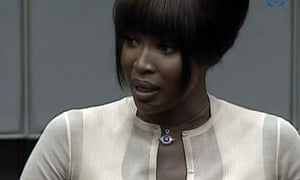The Odum of Ala Igbo
Hail Biafra!
She testified that she received (blood) diamonds from Charles Taylor in the 90s as a gift.
Yup. Just as a "gift".

Yup. Just as a "gift".


Charles Taylor and the 'dirty-looking stones' given to Naomi Campbell
Gems central to prosecution case that ex-president traded weapons for diamonds from RUF rebels in Sierra Leone
Live coverage of the Charles Taylor war crimes tribunal's verdict

A videograb of Naomi Campbell answering questions at the special court for Sierra Leone about a gift of 'dirty-looking stones' after sitting with Taylor at a dinner. Photograph: AFP/Getty Images
Owen Bowcott
@owenbowcott
Thursday 26 April 2012 09.40 BSTLast modified on Thursday 26 April 201210.06 BST
This article is 4 years old
Shares
8
Save for later
The Streatham-born model Naomi Campbell and the US actor Mia Farrow made up a star-studded cast of witnesses summoned to testify about blood diamonds before the special court for Sierra Leone.
Campbell admitted receiving a pouch of uncut gems after a dinner in Pretoria hosted by the then South African leader, Nelson Mandela, in September 1997.Charles Taylor was also a guest.
Campbell and the then Liberian president were sitting together and had been "mildly flirtatious" with one another, evidence to the court suggested. She had accepted the "dirty-looking stones", she told the judges, when they were presented to her later in the night but insisted she had no idea who sent them.
Farrow, who was also present at the meal, contradicted aspects of the model's testimony. She said the next morning at breakfast Campbell told her Taylor had dispatched his men to present her with a "huge diamond" and that she intended to hand it over to Mandela's charity.
The diamond donation goes to the heart of the main allegation against Taylor: that he organised and sustained the Revolutionary United Front's (RUF) invasion of Sierra Leone, trading weapons shipments for looted diamonds.
The former warlord faced 11 charges of war crimes and crimes against humanity during the five-year trial. They included charges of terrorism, murder, rape, sexual slavery, use of child soldiers, forced amputations, enslavement and pillage. He pleaded not guilty on all counts.
Established jointly by the UN and the government of Sierra Leone, the special court has been mandated to "try those who bear the greatest responsibility for serious violations of international humanitarian law and Sierra Leonean law committed in the territory of Sierra Leone" between November 1996 and January 2002.
Three trials, resulting in the imprisonment of eight leaders of the RUF, the Armed Forces Revolutionary Council and the Civil Defence Forces, have already been completed in Freetown, the capital of Sierra Leone.
The UN security council expressed concerns about the potentially destabilising presence of Taylor in Freetown so his trial was transferred to the international criminal court in The Hague. It was subsequently heard in a nearby courtroom in the UN-backed special tribunal for Lebanon.
Advertisement
An initial six-month delay was caused by Taylor dismissing his first legal team and boycotting the court for a time. Prosecution evidence began January 2008. The trial heard from more than 115 witnesses. Closing arguments were made in March 2011.
The complexity of the evidence, the long timespan involved and multiple, international dimensions have added to the judicial burden. The bench consisted of presiding judge Justice Richard Lussick of Samoa, Justice Teresa Doherty of Northern Ireland, Justice Julia Sebutinde of Uganda, and alternate judge Justice El Hadji Malick Sow of Senegal.
Relations between Taylor's charismatic counsel, Courtenay Griffiths QC, and the court were not easy. At one stage Griffiths was summoned to defend himself at a disciplinary hearing after walking out of the courtroom in protest at the refusal to accept his final brief.
The judges claimed it had been filed too late; Griffiths said the delay was caused by other outstanding motions from the court. One judge, Sebutinde, then declined to attend the disciplinary hearing and the matter was ultimately settled by means of an apology.
In his closing speech, Griffiths denied there was any evidence of joint criminal enterprise between Taylor and the leaders of the RUF or other paramilitary factions in Sierra Leone.
"We say, and have said all along, that they are lying," Griffiths said of the prosecution witnesses. "His case is that he was not involved – that he was a peacemaker, not a warmonger."
Taylor, now 64, has repeatedly denied claims by prosecution witnesses that he met Fodoy Sankoh, the RUF leader, at a Libyan training camp. Throughout most of the trial he sat in the dock, wearing a neat suit and tinted glasses.
The court has heard evidence of arms smuggled from Liberia to Sierra Leone in sacks of rice, and diamonds sent back in a mayonnaise jar. Gangs of child soldiers were given drugs to desensitise them to the horror of their actions, the court was told. As many as 500,000 people are estimated to have been killed, systematically mutilated or suffered other atrocities in Sierra Leone's civil war.
During the trial the Boston Globe published a report claiming that Taylor had been once used by the Pentagon's Defence Intelligence Agency as an informant.
Two US government cables released by WikiLeaks and published by the Guardianwere also admitted as late evidence by the court. One quoted the US ambassador to Liberia, Linda Thomas-Greenfield, as saying that "all legal options should be studied to ensure that Taylor cannot return to destabilise Liberia". The second suggested that sensitive information about the trial had been leaked to the US embassy in The Hague.